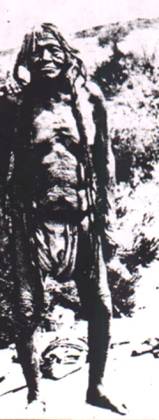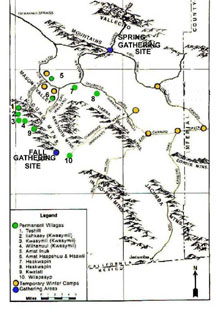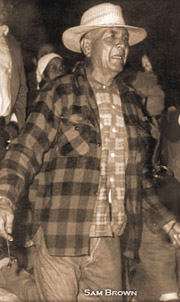 WA
AMAAY KWAKAS.
WA
AMAAY KWAKAS.
Yellow Sky
was acknowledged during a recent Wildcat song practice session and according
to Jon Mesa Cuero, “This song was composed in 1848 or 1849. It presents
the impressions of the composer starting a jouney North from Tecate in
the Sun wise circle of the Tipai villages. Yellow Sky was a man who was
very slender and tall.” (One of the physical characteristics of the
River people, especially the Quechan, is their height. Many well over
six and a half feet.) Thus, according to Jon, “This man was so tall
he could have painted the sky. This is why he was called "pinta el
cielo amarillo" in Tipai, Mai Ta Quas, Paints the Sky Yellow.”
Yellow Sky's father was Kwaaymii and his mother was Quechan (Yuma). Yellow
Sky traveled back and forth to the Colorado River area every spring. He
returned to stay on the Laguna Reservation in 1888. He had a small dwelling
just north of the still existing Tom Lucas' cabin on the main Kwaaymii
village. In his later years SuSaana Klietch, Tom's grandmother, would
often take care of him. He would still access the traditional trails to
the Ipai and Tipai communities that are along and around the Cuyamaca
mountain region. He was frequently recalled as one of the last true traditional
living individuals wearing only basic regalia.
A further
association with the Kwaimii is the Nymii Wilcat song the makes direct
reference to the southern village site Ewiiaapaay or Cuyapaipe. Refer
to village map for song clip and location. (Click map to enlarge and hear
clip.)
Jon is a native speaker of Tipai and is knowledgably of the distinctions
between the different dialects of the Tipai language. In fact there are
many subtleties beyond the variations between Ipai and Tipai. It is not
unusual to find a variation in spelling or grammar that the particular
Band is very comfortable with but may give headaches to linguists. See
the Nymii,
Wildcat page for more on this song style.
 The
timeless quality of the songs and stories carry the Tribal culture from
the timeless past into the yet unknown future. As such the chronological
dates in many of the traditional Native American stories are fluid. This
brings to mind another insight into the oral tradition and the richness
of Native American literature. Jon once told us that his father taught
him this same song about Ewiiaapaay over fifty years ago when he was a
child. As the years went by and he became an adult and caught up in the
day-to-day efforts to provide for a family he had less of a grasp of those
songs he had been taught as a boy. ‘Old’ Sam Brown from Viejas/Los
Conejos reminded him about the Ewiiaapaay story. As he was repeating the
words the tune to the song emerged and he was able to place this Ewiiaapaay
song in a sequence of village/Band geography. Recall and talent are major
influences on each storyteller’s ability to bring the event to life.
Fluidity, almost as much, is the inspiration that sparks the humanity
and glow in our heart to share: thoughts, emotion, joy, sadness and historical
events.
The
timeless quality of the songs and stories carry the Tribal culture from
the timeless past into the yet unknown future. As such the chronological
dates in many of the traditional Native American stories are fluid. This
brings to mind another insight into the oral tradition and the richness
of Native American literature. Jon once told us that his father taught
him this same song about Ewiiaapaay over fifty years ago when he was a
child. As the years went by and he became an adult and caught up in the
day-to-day efforts to provide for a family he had less of a grasp of those
songs he had been taught as a boy. ‘Old’ Sam Brown from Viejas/Los
Conejos reminded him about the Ewiiaapaay story. As he was repeating the
words the tune to the song emerged and he was able to place this Ewiiaapaay
song in a sequence of village/Band geography. Recall and talent are major
influences on each storyteller’s ability to bring the event to life.
Fluidity, almost as much, is the inspiration that sparks the humanity
and glow in our heart to share: thoughts, emotion, joy, sadness and historical
events.
WA
AMAAY KWAKAS (Yellow sky) is a historical Native American from the
turn of the 20th century. He was documented and photographed by the Mesa
Grade resident and prominent ethnographer Edward H. Davis.
In 1915, 28 years after Davis settled in Mesa Grande, a representative
of the Museum of the American Indian, Heye Foundation, made his way up
the mountain to inspect the collection. After negotiations, he purchased
almost the entire collection for the museum. That same year, perhaps with
the funds from the sale of his collection, Davis built Powam Lodge, a
resort hotel with an all-Indian motif. The lodge soon became popular,
attracting visitors to the clear air of the mesa and the opportunity to
hear its proprietor, a talented storyteller, regale the guests with accounts
of his experiences among the Indian people of the Southwest. Davis encouraged
local Kumeyaay artisans to make traditional items of quality to sell at
Powam Lodge, and often hired Indian performers.
A 1916 meeting in San Diego with George G. Heye, the founder and director of the Museum of the American Indian, resulted in Davis accepting an offer to be a field collector of ethnological specimens for the museum. He was delighted. In a 1931 article he wrote for Touring Topics, Davis recalled, “This gave me the very job I had long hoped to create for myself”. It began a relationship with George Heye and his museum that lasted, intermittently, for seventeen years. Historical aside: The New York Heye Collection was a large core collection for the most recent National Museum of the American Indian in Washington D.C.